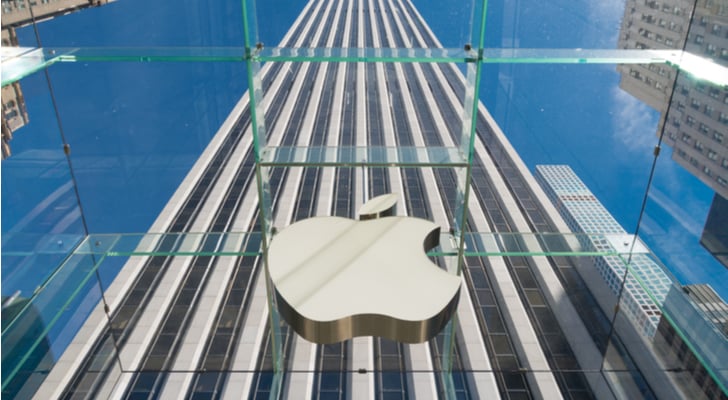Just two months after Apple (NASDAQ:AAPL) announced it would no longer report unit sales of its flagship iPhone, the consumer tech giant warned AAPL stock shareholders that the recently ended first fiscal quarter’s total revenue would come up short of expectations. The reason? Tepid demand for the popular smartphone, particularly in China.
Unsurprisingly, most investors and pundits used the latest development as evidence that the company has lost its magic touch. Others ultimately blame the trade war for its woes, which should presumably abate if-and-when the standoff between the U.S. and China ends. Still others feel CEO Tim Cook is to blame, for not recognizing how quickly the smartphone market would near its maximum potential. It’s possible elements of all three theories apply.
Regardless of the reason, there’s also an upside buried within the hysterics.
The Bad of Apple’s Situation
Per Apple’s Jan. 2 warning, the company is now looking for revenue of about $84 billion for the quarter ending in December versus analyst estimates of $91.5 billion. The company suggested its fiscal Q1 top line would roll in between $89 billion and $93 billion when it posted its fourth quarter results on Nov. 1.
No earnings guidance was offered, but it’s unlikely the consensus of $13.29 per share is still on the table given the dramatic contraction of the revenue outlook.
The cautionary note, in the form of a letter from Tim Cook, explained “Lower than anticipated iPhone revenue, primarily in Greater China, accounts for all of our revenue shortfall to our guidance and for much more than our entire year-over-year revenue decline.”
Anticipated upgrades of older iPhones were also weaker than anticipated for some developed markets.
The outlook, following the decision to no longer report the number of iPhones sold per quarter, confirms the worst suspicions regarding the company. Even if Apple has fallen victim to a war of tariffs and suffered supply constraints (as the warning also suggested), this is the Apple of yesteryear. At least to some degree, the company’s inability to continue creating a “Wow!” factor with its products has allowed rivals to catch up at the same time key markets have approached saturation. As Recode’s Kara Swisher observes, “The innovation cycle has slowed down at Apple.”
Goldman Sachs is also concerned about bigger-picture headwinds, conceding “Beyond China, we don’t see strong evidence of a consumer slowdown heading into 2019,” but adding “we just flag to investors that we believe Apple’s replacement rates are likely much more sensitive to the macro now that the company is approaching maximum market penetration.”
Goldman lowered its AAPL stock price from $182 to $140, mirroring similar target reductions from most other analysts.
The Good for AAPL Stock
In most regards the company’s reality is as ugly the headlines suggest, even if the selling pressure is overzealous.
Yet, the discomfort Tim Cook must have felt in cautioning shareholders now rather than waiting to drop a bomb in them with the official Q1 report slated for Jan. 29, may also serve as a much-needed wake-up call for him and the company’s leadership team.
Chief among those realizations may be that, no matter how advanced and powerful it may be, a smartphone is still just a phone, and most consumers struggle to justify spending $1,000 or more when similar alternatives can be bought for less than half of that figure.
While it’s unlikely Apple intends to shift its aim toward the value-oriented end of the consumer spectrum where Huawei has been making inroads — particularly in China — it wouldn’t be surprising to see Apple becoming more sensitive to the fact that Samsung (OTCMKTS:SSNLF) is making impressive smartphones with a more palatable price tag.
Simultaneously, the warning sends a clear message to any AAPL shareholders that didn’t believe it in early November — the iPhone’s best days are behind it. From here, services are the company’s growth engine, which are a function of the number of total iOS users rather than the number of devices sold during any given quarter. This is a redirection Apple has been trying to put in place for several months now.
Finally, and in that same vein, the revenue warning forces investors as well as the company to deal the optics of a slowing upgrade cycle head-on.
It’s a frustrating two-edged sword to be sure. Owners of existing iPhone don’t need to upgrade, as even the company’s older devices are of such high quality, they’re still performing as well as many newer alternatives from competitors. Higher quality hardware may have inspired loyalty, but it’s prevented many upgrades and smartphone updates from happening as quickly as the company and shareholders would like.
The messaging of the idea hasn’t been as strong or as positive as it could have been, but Apple is apt to better explain the benefits of a large “installed user base” going forward.
Looking Ahead for AAPL Stock
Although jolting, Thursday’s drop won’t necessarily serve as a capitulation. It could take several more quarters for the company to figure out how to rethink itself now that it has finally been forced to look in the mirror. Investors will also have to adjust their expectations of Apple as it shifts its focus from hardware toward digital products and services. That adjustment is underway, but far from complete.
In the meantime, AAPL stock has developed downward momentum, and is surrounded by bearish sentiment. That alone could take weeks to fully work through.
Somehow though, New Street Research’s Pierre Ferragu struck a chord with his note “We nevertheless expect the situation to stabilize in 2020 and EPS growth to resume. The stock is now trading close to 10x our 2020 earnings expectation, a historic low in absolute and relative terms, and see limited further downside to the stock.”
The trick is just knowing when to catch the falling knife.
As of this writing, James Brumley did not hold a position in any of the aforementioned securities. You can follow him on Twitter, at @jbrumley.

